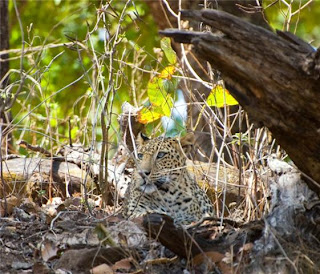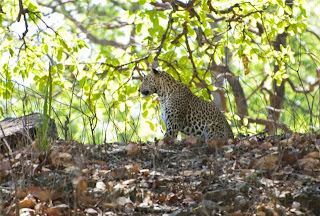In early periods night safaris were not regulated in Kanha National Park. But as a right measure, this was discouraged in toto. It is not a good idea to conduct night safaris in the core zones of any National Park taking into account the disturbance caused and the onus of day safaris which are organized in the morning and evening.
I have always encouraged night safaris among my visitors and have conducted some in the buffer zone...mainly on highways passing through. My preferred route is the road that leads right up to the Kanha NP park boundary from Van Vilas Jungle Resort at Mochha onwards. The night safari route which I prefer is the Mukki Highway and Mocha to Mukki road. The last two are public routes so there is no problem although you may have to notify forest guards or posts on the way. For the first route, it is advisable to contact the first post you come across.
Night safaris are exciting and offer the best chance of sighting less-seen nocturnal animals such as the leopard, porcupine, ratel, Indian fox, civet cats, barking deer, the rare wolf, and more. You can hear night jars and owls and see them under the light. A powerful torch should be very useful albeit care should be taken not to throw light on big cats and bison if you come across them. For large animals, searchlights are not essential as the headlights work fine.
Night safaris are the best way to experience the heart-throbbing delights of tranquil jungle life and its pristine ambiance. Night safaris are being conducted in Rajasthan and as per TOI news, they will be conducted in major NPs and Wildlife Sanctuaries in Karnataka.
Advantages
If properly organized and in the right places, Night safaris at Kanha Tiger Reserve will make tourism more fruitful. Perhaps it will reduce the traffic of day safaris in the core zone.
Night safaris may discourage illegal activities since the roving eyes of the tourists will hinder the movements of poachers and timber smugglers.
It will yield more employment to the locals and add a business to the hotels, jeep owners, and guides. This would be the best way to provide jobs to local guides who often sit jobless due to less tourism inside the core zone.
It will increase awareness amongst the tourists as their scope of understanding this fragile ecosystem will increase.
Caution
The movement for night safaris has to be strictly restricted to nonsensitive areas...away from core zone and breeding zones.
The tourist has to comply with decent behavior, perhaps supervised by the guide as he does so in the day safaris.
The night safaris should be conducted in the same manner as the day safari by the administration...and charged.
The safety of the tourist has to be taken into account.
The timings should be restricted up to 11pm.
I have always encouraged night safaris among my visitors and have conducted some in the buffer zone...mainly on highways passing through. My preferred route is the road that leads right up to the Kanha NP park boundary from Van Vilas Jungle Resort at Mochha onwards. The night safari route which I prefer is the Mukki Highway and Mocha to Mukki road. The last two are public routes so there is no problem although you may have to notify forest guards or posts on the way. For the first route, it is advisable to contact the first post you come across.
Night safaris are exciting and offer the best chance of sighting less-seen nocturnal animals such as the leopard, porcupine, ratel, Indian fox, civet cats, barking deer, the rare wolf, and more. You can hear night jars and owls and see them under the light. A powerful torch should be very useful albeit care should be taken not to throw light on big cats and bison if you come across them. For large animals, searchlights are not essential as the headlights work fine.
Night safaris are the best way to experience the heart-throbbing delights of tranquil jungle life and its pristine ambiance. Night safaris are being conducted in Rajasthan and as per TOI news, they will be conducted in major NPs and Wildlife Sanctuaries in Karnataka.
Advantages
If properly organized and in the right places, Night safaris at Kanha Tiger Reserve will make tourism more fruitful. Perhaps it will reduce the traffic of day safaris in the core zone.
Night safaris may discourage illegal activities since the roving eyes of the tourists will hinder the movements of poachers and timber smugglers.
It will yield more employment to the locals and add a business to the hotels, jeep owners, and guides. This would be the best way to provide jobs to local guides who often sit jobless due to less tourism inside the core zone.
It will increase awareness amongst the tourists as their scope of understanding this fragile ecosystem will increase.
Caution
The movement for night safaris has to be strictly restricted to nonsensitive areas...away from core zone and breeding zones.
The tourist has to comply with decent behavior, perhaps supervised by the guide as he does so in the day safaris.
The night safaris should be conducted in the same manner as the day safari by the administration...and charged.
The safety of the tourist has to be taken into account.
The timings should be restricted up to 11pm.




